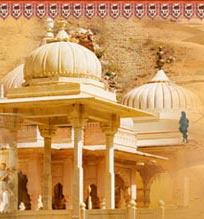 |
This Rajasthan travel guide explores tourism and travel destinations in Rajasthan, one of the most colorful states in India.
Home: Rajasthan Travel |
Rajasthan Travel
Rajasthan is the largest state of the Republic of India in terms of area. It borders Pakistan to the west, Gujarat to the southwest, Madhya Pradesh to the southeast, Uttar Pradesh and Haryana to the northeast and Punjab to the north. Rajasthan covers an area of 342,239 km² (132,139 mi²).
The state capital is Jaipur. Geographical features include the Thar Desert in western Rajasthan and the termination of the Ghaggar River. One of the world's oldest mountain ranges, the Aravalli Range, cradles the only hill station of Rajasthan, Mount Abu, and its world famous Dilwara Temples. Eastern Rajasthan has two national tiger reserves, Ranthambore and Sariska, as well as Keoladeo National Park near Bharatpur, famous for its bird life. Rajasthan has a rich and colorful history making it one of the most popular tourist destinations in India. Shown here is an ancient ruin in Jaisalmer, Rajasthan. Rajasthan was earlier called Rajputana (state of Rajputs) after the ruling class of Rajputs. Rajput literally means 'son of kings'. Rajput clans rose to prominence in the 6th century, establishing kingdoms in Rajasthan and across northern India. The Rajputs resisted Muslim incursions into India, although a number of Rajput states became tributaries to the Delhi Sultanate and Mughal Empire during those empires' peak of expansion. As these empires weakened, the Rajputs reasserted their independence. With the decline of the Mughal Empire in the 18th century, Rajputana become more and more independent. The Rajput kings concluded treaties with the British in the early 19th century, accepting British sovereignty. Ajmer became a province of British India, while the autonomous Rajput states and a few non-Rajput states (Tonk, Bharatpur, and Dholpur) were organized into the Rajputana Agency. Rajasthan's independent kingdoms created a rich architectural and cultural heritage, seen today in its numerous forts, palaces and Havelis, which are complemented by exceptional examples of Muslim and Jain architecture. |








